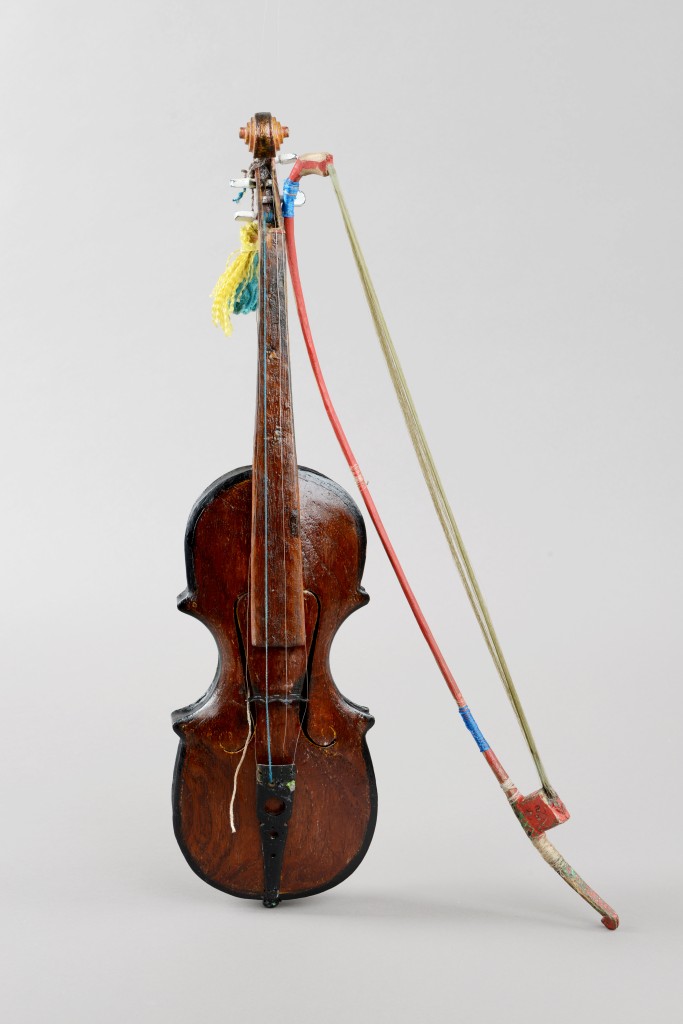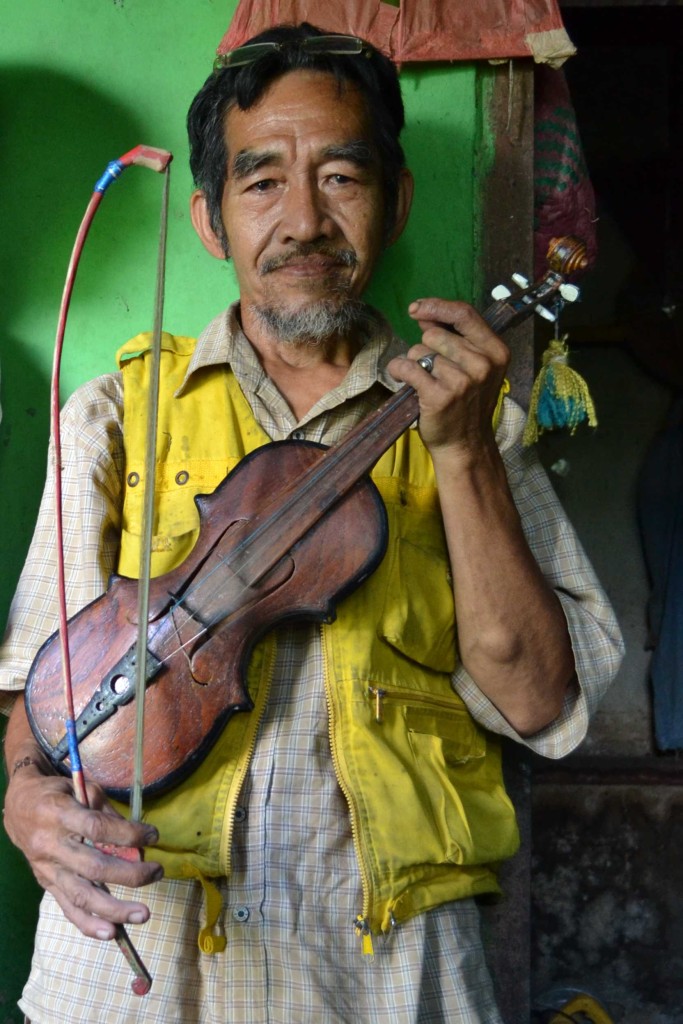By Maria Szymańska-Ilnata

Museum: The Andrzej Wawrzyniak Asia and Pacific Museum in Warsaw
Inventory No.: MAP 20804
Name: Rabab pasisir lute
Author: Dalimus Arip (1951-)
Place of Execution: Indonesia, West Sumatra, Swahlunto
Dating: c. 1985
Material: wood, coconut, metal, string, ant excrements, wire
Dimensions (cm): instrument: height: 64; width: 18; length: 10; bow: height: 64; width: 8; length: 1.5
Image copyright © The Asia and Pacific Museum
The rabab pasisir is part of the collection of musical instruments and is displayed at the permanent exhibition “The Sound Zone” at the Asia and Pacific Museum in Warsaw. It was made by Dalimus Arip in 1985 ca. and used by him until 2015 when it was bought by the curator of the musical instruments collection at the Asia and Pacific Museum during her field research conducted in West Sumatra. Rabab pasisir or biola comes from the region of Pesisir, but has spread to other regions of West Sumatra. The name “biola” refers to the shape of the instrument which resembles the European violin. It is very likely that the violin was brought to Sumatra by the Portuguese who were the first Europeans in that region, and was later adapted by local people to their traditional music. Confirmation of this view of the instrument’s history exists also in the Sumatran classification of instruments which situates rabab pasisir in the category called “asal Barat”, namely “coming from the West”1. It shows the Minangkabau people’s awareness of the origin of this instrument which is called now “traditional”. Rabab pasisir has the shape of a violin but differs in proportions and materials. Almost each rabab pasisir maker introduces his own special feature; for example, some of the instruments are very slim and others more rounded. Coconut is used to make the bridge while buffalo horn is used for the tailpiece. Rabab pasisir has four strings, although only three of them are used. As many musicians and rabab pasisir makers claim, the fourth string is necessary for the “balance”, and cannot be removed although is not necessary for playing.
1 Margaret J. Kartomi, On Concepts and Classifications of Musical Instruments (Chicago: University of Chicago Press, 1990): 225.

Even though the rabab’s shape and construction is reminiscent of those of a European violin, its playing technique is completely different. The player sits with his legs crossed, holding the rabab in a vertical position, propping it against the floor or his foot. The rabab displayed sports a dark stain at the back of the sound box, which – according to the maker and owner of the instrument – marks the place where an opening for inserting the sound post used to be. The opening was filled with excrements of a special kind of forest ants. Inside the sound box there is a little piece of silver paper, folded into a cube (most probably a cigarette package of some sort), on which a magic spell is written, according to the musician.

The rabab is used to provide accompaniment for epical narratives called kaba (earlier tradition) and songs. It is played solo or together with a drum, most often the single-skin rabana, usually to accompany singing.
The Hornbostel-Sachs system of musical instruments classification:
3 CHORDOPHONES / 32 Composite chordophones / 321 Lutes / 321.3 Handle lutes / 321.31 Spike lutes / 321.312-7 Spike box lutes or spike guitars sounded by bowing

Dalimus Arip with his rabab pasisir, May, 9th 2015,
Sawahlunto, photo: M. Szymanska-Ilnata
Dalimus Arip ze swoim rababem pasisir, 9 maja 2015 r., Sawahlunto, fot. M. Szymańska-Ilnata
Bibliography:
Eny Christyawaty i Maryetti. Pemain rabab pasisia: dari pengabdian seni ke profesi. Studi kasus 5 orang rabab pasisia di Pesisir Selatan Sumatera Barat. Padang: Balai Kajian Sejarah dan Nilai Tradisional, 2005.
Erizal. Instrumen musik chordophone Minangkabau. Padang Panjang: Akademi Seni Karawitan Indonesia, 1995.
Hajizar i Muhammad Hidayat Rahz. Tradisi pertunjukan rabab Minangkabau. Bandung, Indonesia: Masyarakat Seni Pertunjukan Indonesia, 1998.
Hartitom. Rabab pasisia dalam lagu Sikambang aia aji ditinjau dari aspek musikologis: studi kusus di kecamatan Lengayang, kabupaten Pesisir Selatan. Padang: Istitut Keguruan dan Ilmu Pendidikan, 1998.
Kartomi, Margaret J. Musical Journeys in Sumatra. University of Illinois Press, 2012.
———. On Concepts and Classifications of Musical Instruments. Chicago: University of Chicago Press, 1990.
Muzeum: Muzeum Azji i Pacyfiku im. Andrzeja Wawrzyniaka w Warszawie
Numer inwentarza: MAP 20804
Nazwa: Lutnia rabab pasisir
Autor: Dalimus Arip (1951-)
Miejsca pozyskania: Indonezja, Zachodnia Sumatra, Sawahlunto
Datowanie: ok. 1985
Tworzywa: drewno, kokos, metal, sznurek, odchody mrówek, drut
Wymiary: instrument: wys. 64, szer. 18, gł. 10, smyczek: wys. 64, szer. 8, gł. 1,5
Rabab pasisir należy do kolekcji instrumentów muzycznych i jest prezentowany na stałej wystawie „Strefa dźwięków” w Muzeum Azji i Pacyfiku w Warszawie. Został wykonany przez Dalimusa Aripa ok. 1985 r. i był przez niego używany do 2015 r., kiedy zakupiła go do muzealnej kolekcji instrumentów muzycznych Muzeum Azji i Pacyfiku jej kuratorka podczas badań terenowych prowadzonych na Sumatrze Zachodniej. Rabab pasisir, zwany też biolą pochodzi z regionu Pesisir, ale jest popularny także w innych regionach Zachodniej Sumatry. Nazwa „biola” odnosi się do kształtu instrumentu, który przypomina europejskie skrzypce. Prawdopodobnie skrzypce zostały przywiezione na Sumatrę przez Portugalczyków, którzy dotarli tam jako pierwsi Europejczycy, a następnie zostały zaadaptowane przez lokalnych mieszkańców do ich tradycyjnej muzyki. Potwierdzeniem tej tezy jest także miejsce instrumentu w tradycyjnej klasyfikacji instrumentów muzycznych z Sumatry, zgodnie z którą rabab pasisir należy do kategorii „asal Barat”, czyli „pochodzących z Zachodu”1. Wskazuje to na świadomość ludzi Minangkabau dotyczącą pochodzenia instrumentu, który obecnie określany jest mianem tradycyjnego. Rabab pasisir ma kształt skrzypiec, ale różni się od nich proporcjami i materiałami, z jakich jest wykonany. Prawie każdy budowniczy rababów wprowadza własne modyfikacje, na przykład niektóre rababy są bardzo wąskie, a inne zaokrąglone. Łupina orzecha kokosowego jest używana do wytwarzania mostka, a róg bawoli strunnika. Rabab pasisir ma cztery struny, mimo, że używane są tylko trzy z nich. Jak deklaruje wielu muzyków i budowniczych rababów, czwarta struna jest niezbędna do zachowania „równowagi” i nie może zostać zdjęta, choć nie jest potrzebna do grania.
Pomimo tego, że kształt i konstrukcja rababów bardzo przypomina europejskie skrzypce, technika gry na nich jest zupełnie inna. Muzyk siedzi ze skrzyżowanymi nogami, trzyma instrument pionowo i opiera o podłogę lub swoją stopę. Prezentowany rabab ma na tylnej płycie rezonansowej ciemną plamę, która – zgodnie z deklaracją budowniczego i właściciela instrumentu – zasłania otwór, przez który włożona była dusza. Otwór ten zaklejony zostały odchodami specjalnego rodzaju leśnych mrówek. Wewnątrz pudła rezonansowego znajduje się także złożony w kostkę mały kawałek srebrnego papieru (prawdopodobnie pochodzący z opakowania po papierosach), na którym – według muzyka – zapisane jest magiczne zaklęcie.
Na rababie wykonuje się akompaniament do epickich pieśni zwanych kaba (starsza tradycja) oraz piosenek. Akompaniując do śpiewu gra się na nim solo lub z towarzyszeniem bębna, najczęściej jednomembranowego, zwanego rabana.
W klasyfikacji Sachsa- Hornbostela:
3 CHORDOFONY / 32 Chordofony złożone / 321 Lutnie / 321.3 Lutnie drzewcowe / 321.31 Lutnie z drzewcem przelotowym / 321.312-7 Skrzynkowe lutnie lub gitary z drzewcem przelotowym pobudzane smyczkowaniem
Bibliografia:
Eny Christyawaty i Maryetti. Pemain rabab pasisia: dari pengabdian seni ke profesi. Studi kasus 5 orang rabab pasisia di Pesisir Selatan Sumatera Barat. Padang: Balai Kajian Sejarah dan Nilai Tradisional, 2005.
Erizal. Instrumen musik chordophone Minangkabau. Padang Panjang: Akademi Seni Karawitan Indonesia, 1995.
Hajizar i Muhammad Hidayat Rahz. Tradisi pertunjukan rabab Minangkabau. Bandung, Indonesia: Masyarakat Seni Pertunjukan Indonesia, 1998.
Hartitom. Rabab pasisia dalam lagu Sikambang aia aji ditinjau dari aspek musikologis: studi kusus di kecamatan Lengayang, kabupaten Pesisir Selatan. Padang: Istitut Keguruan dan Ilmu Pendidikan, 1998.
Kartomi, Margaret J. Musical Journeys in Sumatra. University of Illinois Press, 2012.
———. On Concepts and Classifications of Musical Instruments. Chicago: University of Chicago Press, 1990.
1 Margaret J. Kartomi, On Concepts and Classifications of Musical Instruments (Chicago: University of Chicago Press, 1990): 225